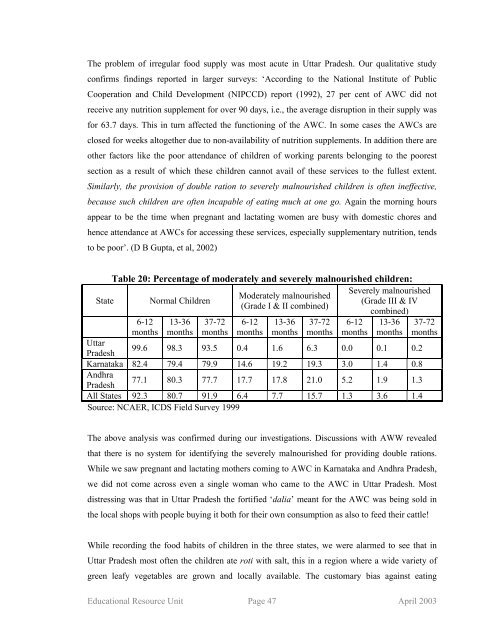Snakes and Ladders - ERU Consultants Pvt. Ltd.
Snakes and Ladders - ERU Consultants Pvt. Ltd.
Snakes and Ladders - ERU Consultants Pvt. Ltd.
You also want an ePaper? Increase the reach of your titles
YUMPU automatically turns print PDFs into web optimized ePapers that Google loves.
The problem of irregular food supply was most acute in Uttar Pradesh. Our qualitative study<br />
confirms findings reported in larger surveys: ‘According to the National Institute of Public<br />
Cooperation <strong>and</strong> Child Development (NIPCCD) report (1992), 27 per cent of AWC did not<br />
receive any nutrition supplement for over 90 days, i.e., the average disruption in their supply was<br />
for 63.7 days. This in turn affected the functioning of the AWC. In some cases the AWCs are<br />
closed for weeks altogether due to non-availability of nutrition supplements. In addition there are<br />
other factors like the poor attendance of children of working parents belonging to the poorest<br />
section as a result of which these children cannot avail of these services to the fullest extent.<br />
Similarly, the provision of double ration to severely malnourished children is often ineffective,<br />
because such children are often incapable of eating much at one go. Again the morning hours<br />
appear to be the time when pregnant <strong>and</strong> lactating women are busy with domestic chores <strong>and</strong><br />
hence attendance at AWCs for accessing these services, especially supplementary nutrition, tends<br />
to be poor’. (D B Gupta, et al, 2002)<br />
Table 20: Percentage of moderately <strong>and</strong> severely malnourished children:<br />
State Normal Children<br />
6-12<br />
months<br />
13-36<br />
months<br />
37-72<br />
months<br />
Moderately malnourished<br />
(Grade I & II combined)<br />
6-12<br />
months<br />
13-36<br />
months<br />
37-72<br />
months<br />
Severely malnourished<br />
(Grade III & IV<br />
6-12<br />
months<br />
combined)<br />
13-36<br />
months<br />
Uttar<br />
Pradesh<br />
99.6 98.3 93.5 0.4 1.6 6.3 0.0 0.1 0.2<br />
Karnataka 82.4 79.4 79.9 14.6 19.2 19.3 3.0 1.4 0.8<br />
Andhra<br />
Pradesh<br />
77.1 80.3 77.7 17.7 17.8 21.0 5.2 1.9 1.3<br />
All States 92.3 80.7 91.9 6.4 7.7 15.7 1.3 3.6 1.4<br />
Source: NCAER, ICDS Field Survey 1999<br />
37-72<br />
months<br />
The above analysis was confirmed during our investigations. Discussions with AWW revealed<br />
that there is no system for identifying the severely malnourished for providing double rations.<br />
While we saw pregnant <strong>and</strong> lactating mothers coming to AWC in Karnataka <strong>and</strong> Andhra Pradesh,<br />
we did not come across even a single woman who came to the AWC in Uttar Pradesh. Most<br />
distressing was that in Uttar Pradesh the fortified ‘dalia’ meant for the AWC was being sold in<br />
the local shops with people buying it both for their own consumption as also to feed their cattle!<br />
While recording the food habits of children in the three states, we were alarmed to see that in<br />
Uttar Pradesh most often the children ate roti with salt, this in a region where a wide variety of<br />
green leafy vegetables are grown <strong>and</strong> locally available. The customary bias against eating<br />
Educational Resource Unit Page 47 April 2003












